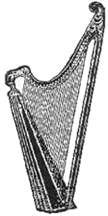|
             
Copyright
Helen Forder
2004
|
|
The
Harp ...continued
|
page 3
|
|
'Anciently, it was said that
it was strung with hair, which continued to be used until the commencement of
the 15th [?] century, up to which period it had only a single row of
strings, but the performer was able to produce the flats and sharps by a
peculiar arrangement of the finger and thumb. But the harp at present
in use has undergone very essential improvement. It extends in
compass to five octaves and one note. The two outside rows of strings
are diatonics, and are both tuned in unison and in any key that the
performer cares to play in. Contrary to the pedal harp, which is played
from the right shoulder, the Welsh harp rests on the player's left
shoulder'.
From The Flintshire Observer, Thursday,
Sept. 2nd, 1886.
|

Triple Harp
|
|
'... I identify the harp,
the guitar, the bagpipes, and ... the tom-tom, inseparably with the music
played upon or sung to them respectively, and believe that these
instruments, to a great extent, can alone account for the different styles
of national melody.'
Brinley Richards. Preface to The
Songs of Wales, 1873.
Click HERE to read an essay on the harp by
Brinley Richards.
|
|
'In order to encourage the
use of the Welsh Harp as the domestic instrument of the Principality, Lady
Llanover (Gwenynen Gwent), gave very handsome prizes for competition,
besides sending over at her own expense, Gruffydd (harper by special
appointment to the Prince of Wales and the Llanofer family), and his
pupils.'
A report on the
Eisteddfod at Caerwys in 1886, in The Flintshire Observer of
September 2nd.
|
|
At the 1886 Caerwys
Eisteddfod, the rules for the harp competitions were laid down by Lady
Llanofer. No-one could compete who had played the pedal harp, '... the object being to restore to its proper position
the national instrument of the principality, and to encourage the
cultivation of the pure and simple style in which ancient Welsh music ought
to be played.'
|
|
In the drawing room of
Newton House, Dinefwr Park, West Wales, there is a triple harp said to be
from the 18th century. Accompanying notes read,
'Presented to VIth Baron Dynevor by J.
Roberts, Harpist North Wales, about 1885.'
'J. Roberts is believed to be John Roberts (1816 - 1894) - Telynor Cymru.'
'From at least the second quarter of the 18th century a room in the
courtyard of Newton House was known as the 'harpers' room' and was used to
accommodate travelling musicians.'
|
|
back 1 2 3 4 next
|
|

